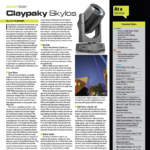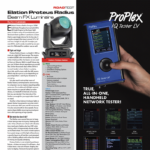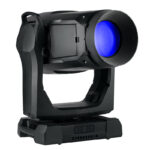Face Panel Hardware
The layout of the face panel is almost typical to other lighting consoles. The playback faders and buttons are on the left side, while the programmer (or “Editor” as RED Lighting calls it) is on the right side. The Editor portion includes a dedicated trackball with buttons to switch between pan-only/tilt-only or to change the speed of the trackball and encoders. Directly above the trackball, there is a grandmaster with DBO button. But unlike other consoles, the REDMX omits a numeric keypad. All fixture selection and manipulation is performed through the 7-inch touch screen and four vertical encoder wheels. There is a bank of 12 physical buttons above the touch screen, which include playback fader page and button page, playback release, default playback selection, store, clear, locate, and hilite (i.e., highlight). There is a dedicated USB port for a work light and one for removable storage on the face panel. The 7-inch color touch screen is a single-touch landscape format monitor, which held its calibration tightly during the evaluation. Above the fader section are two small backlit LCD displays that identify what cue and cue list, or group master, are on each playback. The screens can only display the first five characters of the cue and cue list names. The brightness and contrast of all screens can be adjusted to the operator’s satisfaction in the setup menu.
Back Panel Hardware
The back panel is packed with various connectors. Starting on the left, there are two expansion ports for the REDMX E playback wings. Next is a set of MIDI in/thru/out connections followed by SMPTE via 3-pin female XLR and a DMX input via a 5-pin male DMX connector. In the middle of the back panel is a 100MBit Ethernet connection specifically for ArtNet output. On the right side are two universes of DMX output via both 3- and 5-pin XLR connectors. There’s also a fused power switch with removable IEC cable.
Flip the Power Switch
The console boots directly to the operating system running version 1.07 in under 20 seconds. The Graphical User Interface (GUI) is the focal starting point. The color scheme on the touchscreen does a nice job of separating different functions like fixture selection and the attribute tabs. The fader page, button page, and selected playback are always displayed on the top of the screen. This is also where the encoder and trackball speed is identified. Three options are available at the press of a hard button — 8-bit, 12-bit, and 16-bit (a.k.a. coarse, medium and fine).
There is a hard “Menu” button above the screen. It grants the user access to configuration and setup tasks like patching. The patch screen starts with selecting a fixture type. There are 16 different brands, with one labeled as “Generic Fixture,” where scrollers and dimmers are located. No generic LEDs, like RGB or RGBA, were included. But there is an onboard fixture profile builder in case you need to build your own. (I wouldn’t advise building your own profiles for fixtures that have a large number of DMX channels. It probably makes more sense to simply request them ahead of time from the manufacturer).
To patch a fixture that is already created, select a manufacturer brand and then fixture model type. You will see a window open that displays the fixture name along with fields where you can enter the number (quantity) of fixtures to add, fixture ID, DMX universe number and DMX start address. These fields can only be modified via the encoders.
Navigating the GUI
The default screen view shows all patched fixtures in a 4-by-6 grid, with each cell containing exactly one fixture. From here, selecting fixtures to make groups or manipulate attributes is intuitive. The left side of the screen contains tabs for each type of attribute, and the labels on the encoders reflect which attribute is currently assigned. On the top row, there are tabs to change the screen view, which allows access to groups, palettes, effects and fan feature. The right side contains page navigation soft keys. Although there is no way to permanently store screen views, a “bookmark” feature gives users a temporary reference view as they change between pages.
Programming
Building groups and palettes are a breeze with the encoders and hard “Store” button. The palettes are divided into Intensity (& Strobe), Pan/Tilt, Color, Gobo, Prism, and Blade (Framing Shutters). Once palettes are built, you can easily select groups of fixtures and apply color values and focus positions quickly. After a look is built, it can be stored into a cue. All of the 12 playback faders can be cue stacks if desired, and any of the faders can be configured as a group master.
Once a cue list is built, it can be changed from a cue list to a chase or sequence via the QList screen. The QList window is where the cue timing is changed and the option to link adjacent cues is found. There is no way to link non-adjacent cues. To edit cues, users load the desired cue into the Editor, adjust the cue as desired, then press the hard “Update” button.
Effects
The effects engine has six built-in pan/tilt movement patterns and eight standard effects. The size, base, period and spread are easily modified using the encoders. There is no way to build additional effects for later use, so the built-in options must be used to achieve the desired look. From here, the look with the applied effect can be saved into a cue for playback.
 At a Glance
At a Glance
Compact and User Friendly
With only two DMX outputs on board (and six total via ArtNet) the REDMX is targeted towards small- and medium-sized lighting rigs and venues. This console is designed with the touch screen as the focal point. The operator no longer is required to move between a numeric keypad, external QWERTY key board, or external touch screens. RED Lighting simply omitted peripherals to keep the programmer focused on one user interface, the touchscreen. Command line syntax may be a thing of the past to some, but know that button syntax or button order still matters!
REDMX Features
- 6 Universes of DMX (via ArtNet)
- 7-inch Touchscreen
- 12 Playback Faders
- 12 Playback Buttons
- 4 Vertical Encoder Wheels
- Dedicated Pan/Tilt Trackball
- 3-Pin & 5-Pin DMX Outputs
- DMX Input
- SMPTE & MIDI
- Optional Playback Wing
Pros:
Built-in touch screen, 12 playback faders plus 12 playback buttons, fixture profile builder, setup pages for external DMX consoles for extra faders and buttons
Cons:
No customizable screen views; lack of numeric keypad makes it difficult to select individual fixtures (for example, “fixture 325”). The console also requires two hands for some tasks; there’s no external keyboard and currently no remote application for iOS or Android.
MSRP: Console: $3,679; Extension Wing (12 faders, 36 buttons): $1,199
More Info: www.techni-lux.com; www.red-lighting.com.



